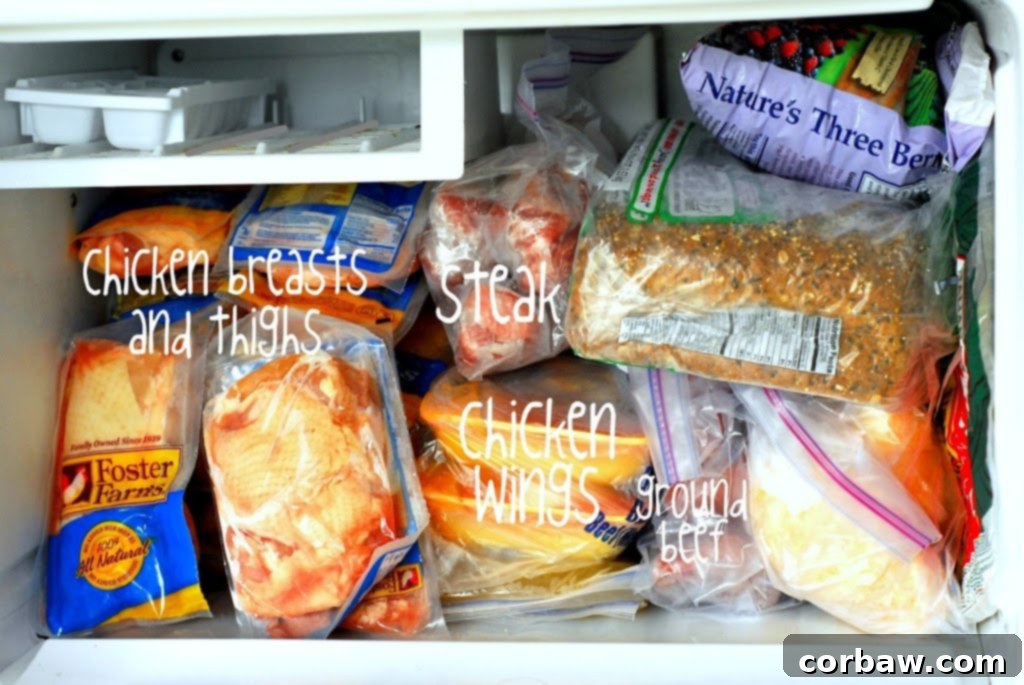Maximize Your Freezer: The Ultimate Guide to Smart Bulk Buying, Meal Prep, and Saving Money
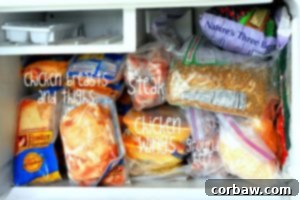
Even the smallest freezer can be a powerhouse in your kitchen, transforming the way you cook, eat, and save money. Forget the days when a freezer was merely a storage unit for ice cream and a few forgotten leftovers. Mine, for instance, may be compact, but it’s an absolute workhorse, proving that you don’t need a sprawling industrial unit to reap significant benefits. It’s not just a home for quick-fix items like fish sticks or chicken nuggets – in fact, you’ll rarely find such things taking up valuable space in my carefully curated frosty domain. Instead, it’s strategically stocked with essentials: hearty loaves of bread, vibrant seasonal berries, creamy blocks of butter, and, most critically, a diverse selection of high-quality meats ready for any culinary adventure.
The Undeniable Benefits of a Well-Stocked Freezer
The concept of a well-stocked freezer is one I’ve championed repeatedly, and for good reason. While the initial outlay might seem a bit daunting, particularly when purchasing in bulk, the long-term financial and time-saving dividends are undeniable. For college students, young professionals, or anyone navigating a tight budget, this strategy is a game-changer. If you’re a student, seriously consider asking your mom for a trip to Costco – and assure her it’s not for jumbo packs of pizza or frozen taquitos, but for ingredients that will sustain healthy, budget-friendly meals. She’ll likely be thrilled! I owe a tremendous debt of gratitude to my own mother, who instilled in me the invaluable habit of buying in bulk. This simple practice has saved me countless hours and a substantial amount of money over the years, providing the incredible convenience of having essential ingredients readily available whenever inspiration strikes or hunger calls.
Bulk purchasing dramatically cuts down on frequent grocery store trips, reducing impulse buys and saving on gas. It’s also a powerful tool against food waste; items bought in larger quantities can be properly portioned and frozen, extending their shelf life far beyond their original “use by” dates. This ensures that expensive proteins and other perishables don’t go bad before you have a chance to use them. Moreover, having a freezer full of options simplifies meal planning. No more last-minute scrambles for dinner – just grab what you need, thaw, and cook. This proactive approach to grocery shopping and meal preparation is a cornerstone of an efficient and economical kitchen.
Your Essential Meat Stock-Up List for a Smart Freezer
When it comes to stocking my freezer efficiently, I rely heavily on the incredible value and quality offered by bulk retailers like Costco. These stores are perfect for sourcing high-protein staples that form the foundation of many meals. My usual suspects, consistently found in my freezer, include:
- USDA Choice Steak: Buying steak in larger, family-sized packs from Costco significantly reduces the per-pound cost compared to traditional supermarkets. I opt for versatile cuts that can be grilled, pan-seared, or even thinly sliced for stir-fries, providing flexibility for a variety of dinner options.
- 90/10 Ground Beef: This lean ground beef is a kitchen hero. It’s perfect for everything from hearty chili and pasta sauces to tacos, burgers, and meatloaf. The 90/10 lean-to-fat ratio provides a good balance of flavor without excessive grease, making it a healthier choice for everyday cooking.
- Boneless, Skinless Chicken Breasts: An absolute staple, chicken breasts are incredibly versatile and a lean protein source. They can be baked, grilled, shredded for salads, diced for stir-fries, or pounded thin for cutlets. Their neutral flavor profile makes them adaptable to virtually any cuisine.
You might notice that the “use by” dates visible in some of the original photos were from about a month prior. Please don’t be alarmed by this; most of these images were captured during a comprehensive restocking session approximately four weeks ago, showcasing the items before they were properly prepped and frozen for long-term storage. When properly packaged and frozen, these meats remain safe and high-quality for many months beyond their original fresh “use by” dates. While not explicitly counted in the cost breakdown because it’s a generous gift, I also frequently have wild-caught salmon in my freezer, generously provided by my dad – an excellent, healthy addition to any freezer collection.
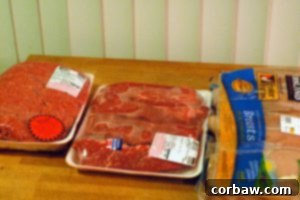
More recently, I’ve discovered another fantastic find at Costco: their bone-in, skin-on chicken thighs. These are a delicious and often more economical alternative to breasts, offering richer flavor and succulence, especially when roasted or braised. Like the chicken breasts, they come in impressively large, budget-friendly packs, perfect for bulk preparation. This is what these flavorful additions look like:

The Real Savings: A Cost Analysis of Bulk Meat Purchases
Let’s delve into the numbers to truly appreciate the economic benefits of this bulk buying strategy. The following calculations are based on meals designed for two people, illustrating how cost-effective it becomes. As mentioned before, please disregard the visible “use by” dates in these photos, as they were taken during my initial stock-up phase. Are you ready to see the savings unfold?
Chicken Thighs: Versatile & Economical
I typically purchase six 2-packs of bone-in, skin-on chicken thighs, totaling 12 individual thighs. This quantity provides at least 6 substantial meals for two, offering excellent value and versatility for dishes ranging from roasted chicken to stews.
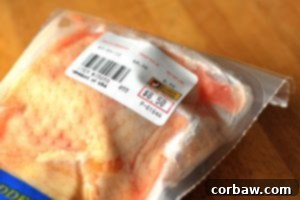
Chicken Breasts: Lean Protein Powerhouse
Similarly, I acquire six 2-packs of boneless, skinless chicken breasts, also totaling 12 pieces. These reliably provide another 6 meals for two, ensuring a steady supply of lean protein for countless recipes.

USDA Choice Steaks: A Treat Without the Splurge
My Costco haul often includes about six impressively large USDA Choice steaks. By strategically portioning these, I can stretch them into approximately 4 meals for two people. While steak is typically a more expensive protein, buying it in bulk significantly reduces the cost per serving.

Ground Beef: The Ultimate Flexible Ingredient
Six pounds of 90/10 ground beef provides incredible flexibility and forms the basis for at least 6 distinct meals for two. Whether it’s for classic tacos, a hearty bolognese, or homemade burgers, ground beef is an indispensable freezer item.

The Grand Total: Unbeatable Value
Adding up these significant purchases: $8.50 (chicken thighs) + $21.32 (chicken breasts) + $27.45 (steaks) + $18.48 (ground beef) totals **$75.75**. For this investment, I’ve secured enough meat for approximately 22 meals for two people, which translates to a remarkable 44 individual meals. This breaks down to an incredibly low average of about **$3.44 per two-person meal** or just **$1.72 per one-person meal**. This calculation underscores the profound financial benefit of bulk buying and smart freezer stocking. It’s far more economical than purchasing individual packages at standard grocery stores, and the convenience of having everything on hand is invaluable. This strategy isn’t just about saving money; it’s about investing in a more efficient, less stressful cooking routine.
Mastering Freezer Prep: A Step-by-Step Guide to Preventing Freezer Burn
Once you’ve made your bulk purchases, the next crucial step is proper preparation for freezing. This process is essential not only for extending shelf life but also for maintaining the quality, flavor, and texture of your meat. Done correctly, it prevents dreaded freezer burn and makes meal prep a breeze. For this tutorial, you’ll need a few key supplies:
- Freezer-safe, gallon-sized Ziploc bags (for outer protection)
- Sandwich-sized Ziploc bags (for individual portions)
- Saran wrap or cling film (for wrapping individual cuts)
- A permanent marker (for labeling – don’t skip this!)

Chicken Breasts and Thighs: Simple Portioning
The chicken breasts and thighs from Costco are often packaged with convenience in mind. They usually come in larger packs that are cleverly perforated into smaller, two-piece portions. This design makes preparation incredibly easy – no additional supplies are needed for the initial division. Simply tear along the perforated edges to separate them into manageable meal-sized packs. Each two-piece portion is ideal for a meal for two people. For added protection against freezer burn, especially if planning to store for an extended period (beyond a month or two), I recommend placing these smaller, original packs into a larger, gallon-sized freezer bag, ensuring as much air is removed as possible before sealing. This creates an extra barrier against frost.

Ground Beef: Perfect Single-Pound Portions
Ground beef is one of the most versatile items in my freezer, and portioning it correctly is key to efficient meal preparation. I typically divide a large pack into six 1-pound portions. While a kitchen scale would offer precise measurements, eyeballing it works perfectly well in a pinch – I’ve found it to be quite accurate for everyday cooking. Once divided, carefully stuff each 1-pound portion into a sandwich-sized Ziploc bag. The critical step here is to remove as much air as possible before sealing. Air is the enemy of frozen food, leading directly to freezer burn. Flattening the beef within the bag also helps to remove air and makes the packages easier to stack and store, optimizing freezer space.
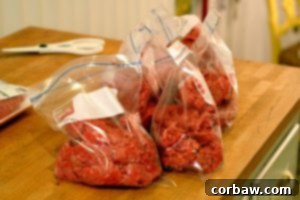
To further protect the ground beef from freezer burn and provide an additional layer of insulation, gather all the individually bagged 1-pound portions and place them together into a larger, freezer-safe, gallon-sized Ziploc bag. This double-bagging method significantly extends their freezer life and maintains quality.
Steak: Preserving Juiciness and Flavor
Costco is known for its impressively large steaks, which can sometimes be too big for a single meal for two. To make them go further and allow for easier portion control, I often cut the larger steaks in half – but don’t tell my dad, who believes a steak should be one glorious, uninterrupted slab! For dinner-sized portions suitable for two, I wrap two steak pieces tightly together in saran wrap. This tight wrapping is crucial for creating an airtight seal around the meat, minimizing exposure to air and preventing freezer burn, which can dry out the steak and diminish its flavor. Each tightly wrapped bundle represents a ready-to-thaw meal for my boyfriend and me.


Just as with the ground beef, after individually wrapping the steaks, transfer these bundles into a gallon-sized freezer-safe Ziploc bag. This final step provides an extra layer of defense against the harsh freezing environment, ensuring your steaks emerge from the freezer as juicy and flavorful as when they went in. Always remember to label all your bags with the date and contents using a permanent marker – this might seem like a small step, but it’s invaluable for efficient freezer management and preventing mystery meals!
With all your meat now meticulously prepared and packaged, it’s ready to be strategically placed into your freezer. This process turns your bulk purchases into accessible, meal-ready portions, maximizing your investment and simplifying your cooking routine.
Beyond Proteins: Other Freezer Essentials for a Fully Stocked Kitchen
While meat forms the cornerstone of my bulk freezer strategy, a truly efficient and versatile freezer holds much more than just protein. Integrating other staples ensures you have everything you need for complete, well-rounded meals and snacks, further reducing last-minute grocery runs and daily decision fatigue. Here are a few other indispensable items I always keep on hand:
- Backup Bread: My freezer is never without a spare loaf of quality bread, like Dave’s Killer Bread. Freezing bread is a fantastic way to prevent waste, especially if you don’t go through a whole loaf quickly. Simply pull out slices as needed, toast them directly from frozen, and they’re as fresh as ever. This ensures you always have bread for sandwiches, toast, or even homemade croutons.
- Shredded Cheese: Yes, you absolutely can freeze shredded cheese! I portion my shredded cheese into smaller bags, usually enough for about a week’s worth of use. This prevents mold and extends its shelf life significantly. While the texture might be slightly different when thawed, it melts beautifully in casseroles, on pizzas, or in any cooked dish, making it a perfect freezer candidate.
- Frozen Berries: A daily smoothie habit is made effortless with a steady supply of frozen berries. I stock up on large bags of mixed berries, blueberries, or strawberries. They’re not just for smoothies; they can also be used in baking, for quick compotes, or as a healthy topping for oatmeal or yogurt. Freezing fresh berries yourself when they are in season and on sale is another smart, budget-friendly tip.
- Homemade Chicken Broth: Flattened bags of homemade chicken broth are a freezer gem. Making broth from scratch uses leftover chicken bones and vegetable scraps, turning potential waste into liquid gold. Freezing it flat saves precious space and makes it easy to snap off portions. It’s infinitely superior in flavor to store-bought varieties and forms the base for countless soups, stews, and sauces.
- Butter: You can’t see it in the main freezer photo because it’s cleverly tucked away in the freezer door, but extra sticks of butter are always present. Butter freezes perfectly and is a foundational ingredient in so much cooking and baking. Having extra on hand ensures you never run out unexpectedly, especially when baking projects arise or you simply need a dollop for sautéing.
These additional items, when combined with your strategically frozen meats, transform your freezer into a true culinary arsenal. It’s about more than just food storage; it’s about building a pantry that supports diverse, healthy, and economical meals every single day.

Freezer Organization: Mastering the Art of “Freezer Tetris”
Once all your items are meticulously prepped and packaged, the final challenge arises: fitting everything into your small freezer. This is where the art of “Freezer Tetris” comes into play. It can indeed be tricky, requiring a strategic approach to maximize every cubic inch of space, but the effort is undeniably worth it for the convenience and savings it provides.
Here are some tips for winning at freezer organization:
- Flatten Everything Possible: For items like ground beef, homemade broth, or even puréed vegetables, flattening them into thin, rectangular packages before freezing makes them incredibly stackable. They can be stored vertically like files in a cabinet, taking up less space than bulky, irregularly shaped containers.
- Utilize Square or Rectangular Containers: If you use reusable containers, opt for square or rectangular shapes rather than round ones. They fit together more snugly and prevent wasted space.
- Label, Label, Label: This cannot be stressed enough. Use a permanent marker to clearly label each package with its contents (e.g., “Ground Beef,” “Chicken Thighs,” “Steak x 2”) and the date it was frozen. This prevents confusion, ensures proper rotation (first in, first out!), and helps you avoid mysterious freezer finds months later.
- Group Similar Items: Keep all chicken together, all beef together, etc. This makes it easier to locate what you need without rummaging through everything and exposing other items to temperature fluctuations.
- Use the Door for Smaller, Frequently Used Items: The freezer door compartments are perfect for smaller items like butter, frozen berries, or even bags of nuts. These areas tend to experience slight temperature fluctuations, so they’re best for items that are less sensitive to temperature changes or will be used relatively quickly.
- Consider Freezer Baskets or Bins: For chest freezers or larger upright freezers, clear baskets or bins can help corral smaller, loose items and prevent them from getting lost at the bottom.
While mastering “Freezer Tetris” might feel like a puzzle, the satisfaction of a perfectly organized and fully stocked freezer is immense. It transforms your small freezer from a cluttered mess into an incredibly efficient and resourceful hub for countless delicious and economical meals. This diligent organization is truly the key to ensuring you’re not constantly resorting to convenient but less healthy options like frozen pizzas or grilled cheese sandwiches for dinner every night.
The Power of a Stocked Freezer: Your Key to Culinary Freedom and Future Aspirations
The strategic use of a freezer, even a compact one, offers far more than just storage; it grants culinary freedom and financial peace of mind. By consistently stocking up on bulk meats and other essentials, you empower yourself to cook more at home, experiment with new recipes, and significantly reduce reliance on expensive takeout or last-minute grocery runs. This proactive approach to food management is a cornerstone of a sustainable and budget-friendly lifestyle. It ensures that delicious, wholesome meals are always within reach, transforming mundane weeknights into opportunities for enjoyable, home-cooked dinners.
My current freezer may be small, but it’s a testament to how much can be achieved with careful planning and smart shopping. Someday, I envision upgrading to two gigantic stand-alone freezers, ready to be filled to the brim with even more incredible findings from Costco and other bulk retailers. Until then, I will continue to hone my skills as a master of “Freezer Tetris,” making every inch count. This little freezer, when properly stocked and managed, truly holds the key to diverse, healthy, and economical meals, ensuring that resorting to pizza or a plain grilled cheese for dinner every night becomes a distant, undesirable memory.
Making the Most of Your Stocked Freezer: Defrosting and Beyond
Now that your freezer is bursting with expertly prepped ingredients, the next logical question might be: how do I properly defrost all this deliciousness? Effective defrosting is just as important as proper freezing to maintain food safety and quality. To learn the best methods for thawing your frozen meats and other items safely and efficiently, ensuring they’re ready for cooking without compromising flavor or texture, head over to my comprehensive guide on Defrosting Dinner: Tips and Tricks for Safe Thawing. Happy cooking!
